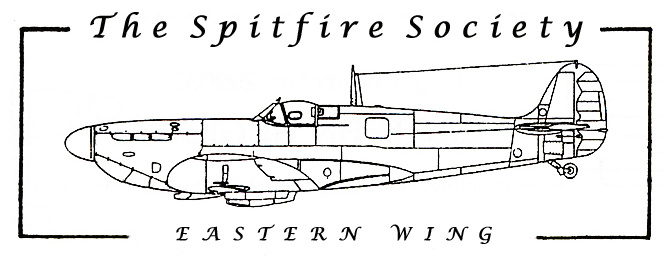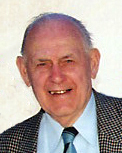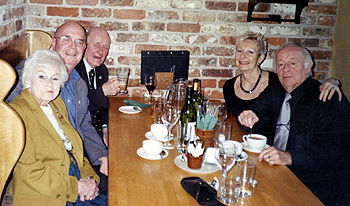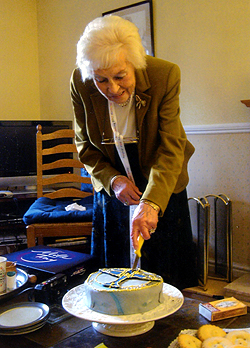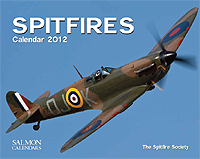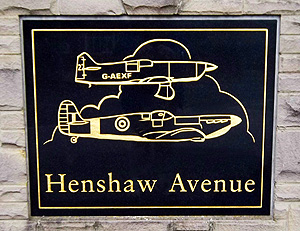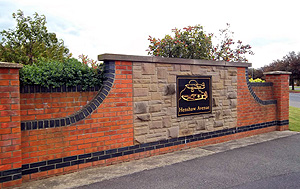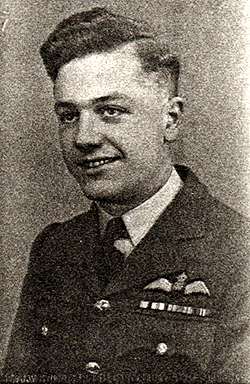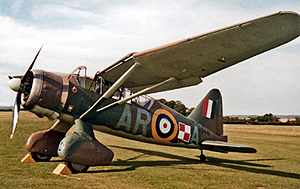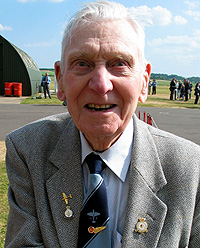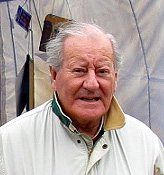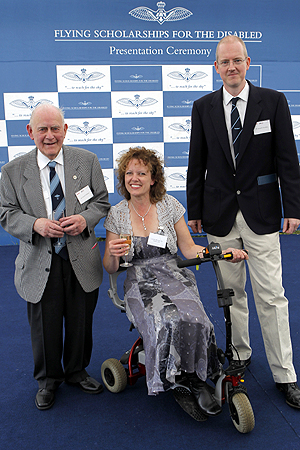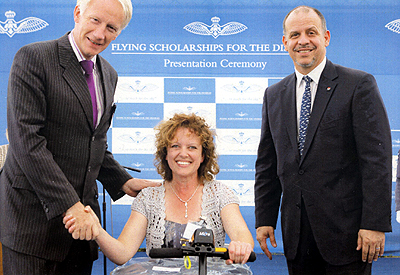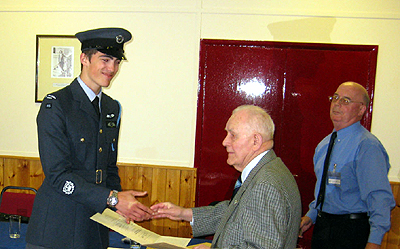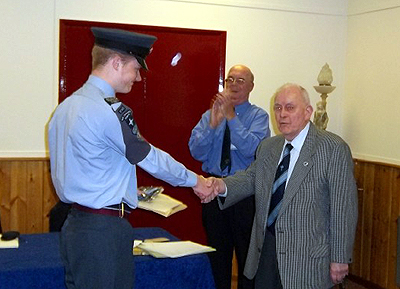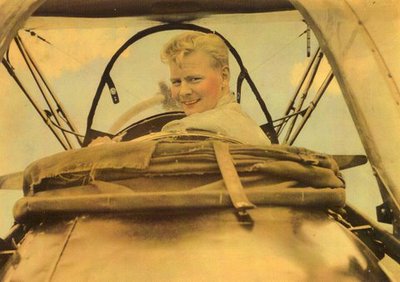 Home
Page Pat
Butler
|
Form 700 No. 58 Winter 2011/2012
INDEX
It Started With an Oil Leak Part II
Flying Scholarships for the Disabled
The Butler-Stillwell Memorial Award
Commemoration of The Battle of Britain
----------
It is always a pleasure
at this time of year after due consideration to be able to say that it
has been a “Good Year” for the Eastern Wing. We have a strong and
dedicated Committee and we will be even better with Cliff Wesson
becoming our new acting Hon. Treasurer. Our helpers’ squad is the
best ever, from the youngsters Jemima and Steven to the very experienced
Audrey Morgan. Sadly the late Doug Bland passing away will be a great
loss and he will be much missed. The future of the Eastern
Wing shines brighter than ever and the ethos of the Spitfire Society
remains paramount. There remains then for me
to wish members old and new a very healthy, happy and prosperous New
Year. “Keep the Faith”. David ----------------------------------- Welcome to Form
700 Committee
News Gerard
Crutchley has now stepped down from his role as acting Hon. Treasurer
which he has been doing along with his numerous other tasks since David
Williams relinquished the role about a year ago. Many thanks for all
your work in this respect Gerard; it has been, along with everything
else you do, greatly appreciated. Welcome on board to Clifford Wesson
who has now taken over from Gerry as acting Hon. Treasurer. Mister
Micawber might advise you thus; ‘Annual income twenty pounds, annual
expenditure nineteen six, result happiness. Annual income twenty pounds,
annual expenditure twenty pounds ought and six, result misery,’ though
perhaps ‘Money is better than poverty, if only for financial reasons’,
may be more helpful. Best wishes and good luck in your new role
Cliff. Readers will be sad to
hear of the passing of Doug Bland who has been a familiar face at our
Air Show Stand and other events for many years; a tribute to him may be
found in this magazine. Other items in this
edition of the Form 700 include the continuation of Geoff Bates
fascinating wartime ‘Ferry Story’, a splendid item called ‘Watch Office’
by Sqn Ldr Ian Blair, part two of Peter French’s ‘It Started With an Oil
Leak’, the Butler-Stillwell Awards and much more. Special congratulations
in this issue to our dear friend Audrey Morgan who in November 2011
celebrated her 90th Birthday. A former wartime WAAF, Audrey
has long been a dedicated supporter of The Spitfire Society and our
region, helping organise and run the sales stand, committee meetings,
events, activities and much else besides. (An interview with Audrey may
be found in the Archives section of our Eastern Wing
website, which details one or two hairy moments for Audrey during the
war!) Happy
Birthday Audrey! It will very
soon be time to start thinking about the activities and events of 2012,
and what better way to plan ahead than with the Spitfire Society
2012 Calendar. With photography by Darren Harbar and James
Wheeler and featuring Spitfires of numerous shapes and sizes, all
airborne, the calendar follows the same successful format as this year;
two sections, each measuring 20x25cm, one with the days of the month
with room on each day for notes, the other with a beautiful portrait of
everyone’s favourite aeroplane. An ideal Christmas
present, the calendar is priced at a mere £5.75 including postage and
may be obtained from Jason Amiss - see
Merchandise page. Wreaths were
once again laid at St. Andrews Church, North Weald and at the Airfield
Memorial adjacent to North Weald Museum on behalf of The Spitfire
Society by Squadron Leader Ian Blair DFM to commemorate Battle of
Britain Day and Armistice Day; thank you Ian. We also extend our
appreciation to Eric Horwood, a steadfast and hardworking member of this
Wing who has dedicated countless hours of his time and energy to
supporting many different aspects of our activities over the years, and
who again obtained the wreathes for the above commemorative services;
many thanks Eric. Diary
Date! The
Spitfire Society Eastern Wing AGM will be held at Old Warden on Saturday
14th of April 2012. Your
support is always appreciated. On a trip up
to Lincolnshire to visit the aircraft of the Battle of Britain Memorial
Flight recently I was travelling with a companion to visit Sandilands
near Mablethorpe, once the home of our old friend Alex Henshaw, when I
was surprised and delighted to come upon a recently-built road named
after the great man himself! I daresay there are plenty of people who
already knew about this, but I’m afraid it was news to me. Henshaw
Avenue boasts marble plaques depicting the two aircraft with which he
will always be associated, the Spitfire and the Mew Gull, each aircraft
picked out in gold bordering. The plaques are mounted in a handsome
sandstone setting upon an ornate brickwork wall on either side of the
entrance to the avenue – which itself has roads such as ‘Comper Swift
Close’ and ‘Leopard Moth Close’ adjoining it. Splendid! PW ----------------------------------- Part III Geoff Bates If you have not read Part I & II, you can find
them here: In luck again
... A number of us, and I was
one of them, were always on the lookout for a new type of aircraft to
get in your log book. You would find out if it wanted delivering even if
it meant going out of your way. If it did need delivering you would see
the senior NCO in charge asking him to book it for you to pick up when
you had completed your present delivery. Landing at Tripoli en
route to Cairo I spotted a Westland Lysander which I learned was
awaiting a tail wheel, which was expected within the next three days. I
booked the aircraft, which had to be delivered to Brindisi in Italy. On
return from Cairo there was no sign of the ‘Lizzie’; my blood pressure
was beginning to rise as Lysanders were a rarity and would have been a
prize capture, when the Flight Sergeant appeared to explain that a
couple of days earlier an Officer, who had night-stopped there, had
quizzed him about the aircraft. On learning it was to be collected in a
day or two he said he would test fly it to save me a job. The aircraft
was gathering speed when it suddenly swung viciously to starboard before
toppling onto its nose and bursting into flames. Fortunately the pilot
escaped unscathed. Evidently a brake had seized causing the aircraft to
veer off the runway and turn over. I managed to get a lift
to Tunis on an American Naval Dakota where my luck was in again; there
was a Warhawk there which had to be delivered to a maintenance unit at
Algiers. After an air test I took off for Algiers. The coastline between
Tunis and Algiers is extremely rocky and it would be impossible to carry
out a forced landing if you lost your engine; the only option would be
to bail out, which didn’t appeal to me! I was about three quarters of
the way to Algiers flying at 5,000ft when my engine cut dead. I dived to
see if I could restart the engine with no joy, but I was in luck as immediately below me was
a small auxiliary RAF station. I called up for an emergency landing but
was told to go round again as there was a steamroller on the runway
repairing potholes. I told them in no uncertain terms that I couldn’t go
round again without an engine. I managed to land on a peri track with
vehicles and personnel hurriedly getting out of my way! I often wondered
how I would cope in an emergency and was amazed how calm I felt. I
reported to Flying Control and was greeted with the words “I expect you
could do with this,” and was handed a mug of tea. I put it down as
quickly as I could hoping no-one had noticed my shakes; I obviously
wasn’t as calm as I thought I was! My luck was in again for
had my engine cut a minute earlier or later I would have been some four miles
away. It would have been impossible for me to make the runway, leaving
me with no option but to bail out. One more piece of luck. There was a
Spitfire there to be taken to the maintenance unit at Algiers. The only
other way to get back to base would have been for them to send an
aircraft to fly me out. Homeward
Bound Much to my surprise six
of us were told one morning that we were to be posted to Melton Mowbray
tomorrow because of the shortage of pilots in the U.K. to ferry aircraft
abroad. So we hastily got packed and our mess bills etc. paid. We were in for a busy
time; first of all we converted onto Mustangs, Tempests, Corsairs,
Hellcats and Vultee Vengeance Dive-Bombers, which none of us liked.
Fortunately my time on the latter was limited to the time I spent
converting onto them. One of our unit had to bail out of a Vengeance
when it caught fire south of Ajaccio in Corsica. His body was found on a
beach with his parachute which had failed to open. Ironically he was
courting a WAAF parachute packer. We were kept busy flying
an assortment of aircraft, mainly to Cairo, Karachi and Nagpur in
central India. A one-off was a delivery of a Corsair to Malta for the
Fleet Air Arm. On return from a trip to
India I was greeted by the Flight Commander as I passed his office, like
a lost friend. “Just the fellow I want to make up a party”, he said.
Sounded exciting! “What sort of party?” I enquired. “Your old unit at
Blida in Algeria have a lot of work on and we are sending six pilots to
them for a few months to help out; I’ve got five and you complete the
party”. I vehemently protested that I had spent all but six weeks of my
service time abroad and that there were several pilots on the unit who
had never been abroad. The reply I got was that all the other pilots
were away on trips and the six of us were urgently required – “anyhow,
it’s only for a few weeks”. I had heard that all before. No amount of
pleading was going to get me off this ‘temporary’ posting. I was handed
my rail ticket and told to report to the Aircrew Holding Centre at
Morecambe in Lancashire. Why if the posting was so urgent were we not
being flown directly out to Blida? One chap was not happy to
be posted home as he was having woman trouble. The five of us decided to
write to our MPs to seek their help. I was the first to receive a reply
and when the Adjutant saw it he nearly had a fit. “I’m not having
my name raised in the House,” he said and dashed to the notice board and
tore down the posting list with our names on it. The outcome was that I and
one other were sent back to Filton and the other three were grounded.
This left ‘Lover Boy’. He was so concerned that he might be taken off
the posting that he saw the Adjutant and within a couple of days he was
on his way to Blida. I don’t know whether the girlfriends ever caught up
with him!
To be continued… ----------------------------------- Part
II Peter
French The following piece was written by former wartime
pilot the late Peter French and originally appeared in a magazine called
‘The Seadog’ of which Peter was Editor. A Seadog, as we all know, is a
type of small, centre-cockpit ketch-rigged motor/sailing boat and Peter
was an enthusiastic owner and sailor of one of these handsome vessels.
Our thanks to Mrs French for forwarding the article to us and for kindly
granting permission for its reproduction here in the Form 700. If you have not read Part I you can find it here: It was much darker over
the land, and while my eyes adjusted to the fading light, and my
heartbeats returned to near-normal, I flew just above the tree-tops,
half in and half out of the cloud base, searching for somewhere to put
down. The first big field I came to had been newly ploughed, but another
nearby was grass covered, and at first sight looked promising. But when
I flew nearer, I noticed that its surface was studded with concrete
anti-glider-invasion posts. As I circled in the deepening twilight to
ponder my next move, I glimpsed the distant lights of vehicles heading
in my direction. While a wheels-up landing
on the ploughed field would have been relatively safe, the resulting
Court of Inquiry into the cause of the damage would have led to a
court-martial for me, for having taken the aircraft without permission.
The alternative - to attempt a landing with the wheels down, in the near
dark, in a field stiff with concrete posts, would be a tremendous
gamble, if not an act of lunacy. With no time for second
thoughts, and convinced that I might get away with it, if only I could
get the aircraft back on the ground in one piece, I decided to gamble my
chances on the field with the concrete posts. With undercarriage down,
then flaps down, as slowly as I dared, I brought her, hanging on the
propellers, low over the hedge. I chopped the throttles and she dropped
like a stone to the ground. Then using brakes and engines alternately in
a life-or-death chicane, zigzagged violently the length of the field in
the wildest ride of my life and by some miracle escaped crashing into
the posts. My heart raced as the aircraft bucked and skidded its way to
a standstill. Then, quite unable to believe my good fortune, I sat dazed
for a while with the engines ticking over. My next thought was,
where to leave the aircraft in safety? Nearby was the dark silhouette of
a haystack. My hand was poised ready to blast the port throttle wide
open to swing the aircraft towards it, when I spotted, only feet away,
another of those concrete posts. One moment more, and I should have
smashed straight into it. That shook me more than all that had gone
before - I could have thrown it all away in one simple act of
carelessness just when I thought the job was done. Sick at the realisation,
I taxied the aircraft past the post to the lee of the haystack and
switched off the engines. Scarcely had I finished fitting safety locks
to the flying controls when a stream of Army vehicles swept into the
field and in seconds I was encircled by soldiers. The young
officer-in-charge treated me with courtesy, despite having some idea, so
I learned later, that I might be a spy. After brief interrogation, I was
placed under close arrest. An armed guard was
mounted over my aircraft, and I was taken under escort to the
Headquarters of the Searchlight Battery at the village of Grindale, from
which the soldiers had come. Having just flown in from the North Sea in
wartime, unannounced, and in near darkness late on a foggy winter's day,
I was not overly surprised at being treated with suspicion by the Army.
There was a curious twist to events that night, for when the Army
officer telephoned to check my story, the R.A.F. authorities told him
that a pilot resembling the man he described had been reported killed
that afternoon while flying an Airspeed Oxford in fog over the Yorkshire
Moors. Orders were given that I
was to remain in custody until identified. My overnight stay at the
Army Searchlight Battery was memorable. The kindness shown to me, and
the generous hospitality with which they welcomed me into their Mess,
was exceptional. As the evening wore on and the drinks flowed, I
discovered that the cliffs over which I had flown were at Flamborough
Head, and rise nearly four hundred feet above sea-level. Next morning, an officer
from my base arrived, and after identification, I returned with him,
wondering what sort of reception awaited me. Much to my surprise, no
disciplinary action was taken - neither then, nor later. Perhaps there
was a feeling that I had already paid the price for my
foolhardiness. Of course, the Oxford had
to be returned to base. Flying it out appeared to be the obvious thing
to do, so men with tractors ripped out all the concrete posts and
smoothed over the holes. Then, because the Royal
Air Force has a regulation which bans pilots who have made a forced
landing from flying their aircraft out again, another pilot was
delegated to do the job. He took one look at the field and declared that
he was not prepared to chance such a risky take-off. A second pilot was
sent. He too refused to fly the aircraft out. In the end, I was summoned
to the Flight Commander's office and told "You put it in - you get it
out!" - which was, I suppose, a kind of poetic justice. But getting the Oxford
out was not to be a simple matter. Experience had taught me that landing
an aircraft in a small field was easier than flying it out again. To
succeed, everything had to be exactly right, but here, the odds were all
against me. I flew to Lissett
aerodrome just south of Bridlington, then went by car to the farm at
Grindale where my aircraft lay waiting. One look at the take-off run
told me why other pilots had refused to take on the job. It was short,
shorter than I had remembered. This meant that I should have to await
the arrival of strong winds to help lift the aircraft into the air. When
the next weather system bringing strong winds set in some three days
later, I returned to the farm. After engine and airframe
checks had been carried out, and the aircraft partly refuelled, I taxied
into position for take-off, opened the throttles and hoped for the best. Full
of promise, the Oxford charged forwards over the tufty grass, but speed
built slowly. Soon it became apparent that I had not a hope of getting
her airborne before reaching the end of the field. I whipped back the
throttles, smacked on the brakes, and brought the aircraft to a
standstill. Nor was the second attempt any more successful - the drag of
the landing wheels sinking into the soft ground slowed the aircraft as
surely as if the brakes had been applied, and I was forced to abandon
that run also. Determined not to give up
without some sort of a fight, I decided, as a last resort, to try a
tactic I'd used with great success some years earlier, during
experiments towing giant tank-carrying gliders with equally huge
four-engined heavy bombers. So I taxied to the downwind boundary, swung
the aircraft round to face into the strong wind, then locked on the
brakes as hard as they would go. Next, I lowered the flaps
a little, opened the throttles to their widest, and rammed the control
column hard forward. Slowly the tail lifted. When, everything was
thundering and juddering fit to burst, I suddenly released the
brakes. The Oxford leapt forward,
and as she hurtled over the bumpy grass, I hung on, and with all my
might willed her desperately into the air.
To be continued … ----------------------------------- Sqn Ldr Ian Blair DFM
What ever did we do before Air Traffic Control existed? Simple - we had a ‘Duty Pilot’ (DP) ably assisted by the ‘Airman of the Watch’ (A of W). In the mid 1930's, I left apprentice training and was posted to 101 Sqn at Bicester, where I was to become familiar with ‘The Watch Office’ (WO) as an AC2 Arm/AG. The WO was a small wooden building, right on the edge of the grass airfield (no runways). It faced outwards towards the vast expanse of the field with panelled windows (no picture windows in those days) and the aerodrome usually visible along the maximum length and width (sometimes there was a dip in the airfield surface and sight of a landing aircraft could be lost for a moment). The WO usually had two rooms, a toilet and a small area where the ‘brewing up’ was done. The main room had a desk facing the window where the DP sat. Opposite, on the window ledge, were an array of items including an Aldis Lamp and coloured screens, Very pistol, binoculars and landing compass. Adjacent were 2 x 6ft tables on which the radio link of the closed circuit weather broadcasts equipment was located. It was the duty of the A of W to take down these broadcasts at regular times throughout the day (this radio link was direct to the forecaster who I think was at Uxbridge, but it may have been Andover at that time). In addition the DP gave a local visual on the weather i.e. the horizontal visibility, wind speed and direction and estimated height of cloud base. With experience, this ‘chore’ was delegated to the A of W. Working in the same location, the A of W logged all aircraft movements IN & OUT in the Watch Keeping Log. As far as I can remember the WO hut was on the camp central heating system, so there was no requirement for the A of W to light any stove. The only daily requirement was to "bumper" the office floor (Grade 1 lino), open up the WO at about 07.00hrs and take down from the weather broadcast system the first weather reports. Prior to all this, the keys of the WO had to be collected from the Guardroom and the "dry rations" collected from the airmen's mess, all done on foot or by issue bicycle - you didn't get any transport. At the rear, inside the building, there was a large steel cupboard built into a brick wall, part of the WO known as the ‘Ready for Use Pyrotechnic Store’. It contained a very limited amount of Very cartridges (various colours), rockets, port fires, signal projectiles and igniters (friction operated) and a few ground smoke generators. Because of the requirement to operate the signal mortar, the A of W was usually from the Armament Trades. The duty was routine but because of the requirement, the Armament Trades were excused the extra duty of Fire Piquet. The A of W did of course carry out the Duty Armourer duties which were separate to that of A of W duty. Outside of the watch office was of course the Ground Signal Area, which I am sure you will all remember - a large square with a large white "T" and the wind sock. There were other signals, eg dumbbell, "R" &" L" (circuit indicators), each with their standard meanings. On instructions from the DP the A of W changed each of these. There was also the Station Identification Letters which were permanent. There were two other features adjacent to the signal area, these were: 1. A six foot steel pipe about 2” in diameter, set at an angle of about 80°. This was the firing stance for the rockets. The sticks which were about 8ft long were inserted into the pipe and the "blue touch paper" ignited with a port fire. 2. A large concrete square (3ft sq.) into which was cemented a solid cast iron base mounting for the barrel of the signal mortar. The mortar barrel was high tensile steel, 3" diameter and about 3ft long. At the bottom of the barrel there was a small external hole at right angles to the centre line of the barrel - into this hole was inserted the friction igniter. This in turn was connected to a lanyard some 12ft long. The signal projectile and propelling charge came in a sealed tin about the size of a large can of fruit. When required for use the armourer would fit and secure the barrel to the permanent base plate with a steel pin, drop the powder bag into the mouth of the barrel (rammed down with a special ‘ram rod’), then slide the projectile gently to the bottom (it rested on an internal ridge). Then he would insert the igniter, run the cable out to its full length and connect the cable hook to the firing hook on the igniter. When the DP gave the ok, usually coinciding with the noise of an aircraft overhead, the A of W would give a strong tug on the lanyard handle. There was an almighty explosion and the projectile shot skywards to burst with a bang and flash at a height of 1500ft. The whole purpose of course was to indicate to aircraft in the vicinity that there was an airfield below. In the absence of any navigation aids, it was then up to the pilot to get himself on the ground - he didn't necessarily know where he was. The rockets mentioned were used for the same purpose with the height of the burst being somewhat lower (800ft), but the same procedure was used in low cloud conditions. Adjacent airfields would usually telephone the DP if help was required, that is to say low cloud base, day or night, and when an aircraft was lost or overdue. You can see a facsimile of a Watch Office (Northolt) at the RAF Museum Hendon. How things have changed! IB ----------------------------------- Doug Bland
Sadly in August of this year we lost a great friend and one of our most loyal colleagues when Doug Bland died. For many years Doug enthusiastically supported us at regional events and activities and was a dedicated team-mate on the Spitfire Society sales stand at air shows. His speciality was in the vital role of selling our raffle tickets, a task at which he excelled and at which he worked extremely hard though making what to many can be a tiresome job look easy, greeting the public with his calm, relaxed conversational style which, along with his engaging smile soon had people virtually queuing up to buy a ticket from him. I think this was Doug’s secret and the reason he made it look easy – he genuinely enjoyed every minute of what he did. Doug was a true gentleman, a man of great warmth, kindness and compassion and working as he did for us in the front line with his great knowledge of Spitfires and the RAF he was a truly fine ambassador for The Spitfire Society; we were very lucky to have him on our team. It was always a pleasure spending time in Doug’s company, his gentle humour warming our spirits on the chilliest of Duxford mornings. The sales stand will not be the same without Doug; he was our friend and we shall miss him very much. We extend our sincerest condolences to Doug’s family. PW -----------------------------------
Steve Williams On the 19th October 2011 I was fortunate enough to be invited to represent The Spitfire Society, Eastern Wing, at the official opening of the "Grandma Flew Spitfires" exhibition at the Maidenhead Heritage Centre. This is a permanent display and archive based on the work of the Air Transport Auxiliary which had its headquarters at nearby White Waltham airfield. Our Chairman Mr David Evans, and Mr Chris Brice for the Society's central "Len Stillwell Bequest" fund also attended. The opening ceremony was performed by H.R.H Prince Michael of Kent who demonstrated a considerable knowledge of the A.T.A. in his remarks. Other dignitaries speaking were Air Vice Marshall Stephen Hillier for the R.A.F., Commodore of the A.T.A. Association Mr Peter Garrod and the Mayor of Windsor and Maidenhead Councillor Asghar Majeed. A remarkable twenty three veterans were present. Dominating the whole scene was the Spitfire simulator, fifty per cent of the costs for which were paid for by the Eastern Wing's charities fund. This was certainly a major attraction and many of the guests, including Prince Michael, spent a considerable time "playing" with this marvellous piece of equipment. I would like to thank the Chairman Mr Richard Poad and his team of hard working volunteers for a most memorable day and wish them every success for the future. http://www.atamuseum.org/index.html
----------------------------------- Flying Scholarships for Disabled People
Gerry Crutchley As I’m sure you all know by now, our friend, the late Len Stillwell, bequeathed a large sum of money to The Spitfire Society equally split between HQ and the Eastern Wing. Here at Eastern we have been carefully looking into worthy causes that we feel Len would have been happy for us to support. After much consideration, Eastern chose Flying Scholarships for Disabled People (FSDP), a charity in memory of Group Captain Douglas Bader ‘dedicated to helping disabled people to discover their true potential through the mental and physical stimulation of learning to fly a light aircraft’. Last year we awarded FSD a grant of £10,000 which allowed us to sponsor one of nine students in 2011. Other sponsors included The Red Arrows Charitable Trust and The Royal Air Force Charitable Trust. The award pays for the student to have flying tuition, ground school and supporting exams. Scholarships take place in South Africa as well as UK flying schools. The selection process for our student began in February this year and in April it was announced at RAF Cranwell that our student would be Laura Branigan. In July 2011 David Williams and I were invited to RIAT at RAF Fairford where Laura and the other students were awarded their scholarship certificates by His Royal Highness Prince Faisal of Jordan. To date, the weather has not been kind to Laura and she still has some of her 35 flying hours left to complete, but she tells us she has definitely got the flying bug and wishes to pursue her training. We wish her well and look forward to seeing her next year again at RIAT.
http://www.fsfdp.org.uk/index.html
ACM Sir Stephen Dalton, Laura and HRH Prince Faisal
---------------------------------- The Butler-Stillwell Memorial Award Once again the awards presented to Air Training Corps cadets in the name of Eastern Region Founder Pat Butler and former committee member and benefactor Len Stillwell went to two outstanding young gentlemen; Cadet Warrant Officer Andrew Monk
Andrew Monk joined the Air Cadets in the summer of 2004. He completed his solo and advanced glider training in February 2008 aged 16 in the Viking glider at RAF Syerston. From there he went on to join 614 Volunteer Gliding Squadron where he is currently training as an instructor so that he may help new Air Cadets towards solo flying. Andrew was awarded three flying scholarships through the Air Cadets, becoming the top pilot on the Air Cadet Pilot Scheme in 2009 and was awarded a further twelve hour flying scholarship through the Air League. In 2009 Andrew also gained his Private Pilot’s Licence at RAF Wyton Military Flying Club and has since achieved the club aerobatic rating. During his time in the Air Cadets Andrew has also gained the Gold Duke of Edinburgh’s Award and he was also the first cadet from the London and South East Region to become a qualified Aerospace instructor. Andrew’s ambition is to become a pilot in the Royal Air Force, the application for which is currently underway. I am certain that with the drive and determination that Andrew has shown in his time with the ATC this ambition will soon become realised. (Andrew flew into Old Warden for the awards ceremony in a light aircraft, the only cadet thus far, as far as I am aware, to do so!) Cadet
Warrant Officer Henry Wisdom
CWO Henry Wisdom is also a remarkable person who has achieved many great things – including becoming the 1066 Squadron Bandmaster (Henry is a gifted trombonist) - and was given glowing recommendations for our award by his Commanding Officers, brief extracts of which are included below; ‘CWO Wisdom this year completed his flying scholarship and received a very good report. He was also picked as one of the winners of the Duke of Westminster Award through the CVQO. He was one of a group of cadets who were given a once in a lifetime trip to South Africa to participate in various charity projects. Wisdom has recently been selected for his CWO position having passed his interview due to his high commitment and obvious abilities in being able to carry out this role. He is respected by both his peers and staff and is always approachable and an ambassador for the squadron on community events. I believe that if he received this award he would be a great ambassador for the Air Training Corps and is well deserved of being considered this year for this prestigious achievement.’ Flt
Lt H. Callaghan ‘I have seen CWO Wisdom evolve from cadet to Flight Sergeant and soon Cadet Warrant Officer; in his time at 1066 (Hitchin) Sqn he has always taken on the tasks presented to their highest level and has always strived to do the best job he could. CWO Wisdom is a very mature young man who has already planned out his career having used the ATC to the best of his abilities and will continue to assist the ATC beyond his ATC time.’ Wg
Cdr Paul Mimpress Two most worthy recipients of the Butler-Stillwell Awards who clearly represent the spirit of the Spitfire and whom I am sure Pat and Len would be proud to have associated with their name and their memory. May I take this opportunity on behalf of the Eastern Wing and the whole of the Spitfire Society to wish them the very best for their future careers; good luck chaps, and do please stay in touch. A final note from Steve Williams: ‘For some time it has been the Committee's ambition to make an award solely bearing Len Stillwell's name. The exact parameters are the subject of negotiations with the Air Cadets, but it will be distinctly different from the long standing Pat Butler Memorial Award. The first presentation will take place at the Eastern AGM in April 2012.’ More information on this award can be found on the Pat Butler Memorial Award page PW ---------------------------------- 71 Year Old Crash Site Found in Lake Muskoka, Canada On a recent trip to Canada I came across this story in The Muskoka Sun. I know that there has been a fair amount of discussion on the internet concerning this incident so I thought some of our visitors might find it interesting. GC LAKE MUSKOKA — It’s been more than seven decades since a mid-air collision claimed the lives of four pilots over Lake Muskoka, but for the families of two of those pilots the final chapter in their story was never written. That is until a group of determined local men found what could be the final resting place of Peter Campbell and Ted Bates (photo).
“This is our honour and our duty,” said Al Bacon, a member of the Lost Airmen of Muskoka Project (LAMP). “These were our servicemen and they’re heroes as far as I’m concerned.” Since 2004, LAMP has been investigating more than a dozen known Second World War-era plane crash sites in Muskoka, but their focus has been on one crash in particular. On Dec. 12, 1940, a training flight out of Borden went missing in a blizzard, touching off a massive aerial search the following day. “They put 50 aircraft in the air the next day from Borden and they searched from Georgian Bay to Sudbury to Trenton looking for that one plane,” said Bacon. “Two planes came over Lake Muskoka and they were making a turn to go into the airport to refuel when they collided. They both went down.” One plane was recovered in early 1941 and the bodies of the two pilots, L. Francis of Glamorgan, Wales and W.P. Gosling of Edmonton, were recovered. The second plane, an RCAF Nomad 3521, and its passengers became the subject of a massive search in the weeks that followed. According to several articles that appeared in late 1940 and early 1941 editions of the Toronto Star, the only sign of the accident was an oil slick on top of Lake Muskoka, but that didn’t stop extensive recovery efforts that included more aerial searching, dragging the lake, and sending in a diver who called his seven dives at 120 feet in Lake Muskoka the closest to death he had ever come. But with the war raging in Europe, the crash had largely been forgotten within a few months by everyone except the families of pilots Peter Campbell, 24, of Sussex, England and Ted Bates, 27, of Guelph. When the team of Al Bacon, Matt Fairbrass and Don Ruud began LAMP, the search was renewed. “It would give closure to their families, and that’s what it’s all about,” said Bacon. “If they don’t find the bodies then those families have no closure, even though their names are down on Green Island (the Commonwealth Air Force Memorial) in Ottawa marked as grave unknown.” The group tracked down archival records and eyewitness accounts of the crash until slowly they were able to narrow down the possible locations of the missing plane. “We made a discovery of a site of interest,” said Bacon. “We had what they call a Hummingbird, which is actually a fish finder, but it showed a plane, or what we thought was a plane at least.” That was when LAMP decided to call in the experts at OPP search and rescue. “I wrote a letter to Julian Fantino, who was the commissioner of the OPP at the time, and asked if they would help us. It went down the chain of command to the underwater search and rescue team,” said Bacon. “Believe me, they’ve done a marvellous job. They’re the ones who actually discovered it.” OPP said the discovery was initially located by members of the OPP Underwater Search and Recovery Unit (USRU) utilizing side-scan sonar technology. A dive was conducted at the site on July 27, 2010. Police said
evidence clearly identifies that the aircraft is the Northrop Industries
A-17 Nomad that was involved in a mid-air collision over the lake in
1940. Bracebridge OPP confirmed the find on Tuesday, July 26. Police
won’t reveal the exact site of the crash to protect it from being
disturbed or scavenged. But Bacon and other news reports say it is
located somewhere near Browning Island. OPP said divers have not located
any human remains, but have located artifacts and personal effects.
Police said OPP and the Coroner’s Office believe the remains may not be
recoverable. Police said the families of both men have now been contacted: Campbell’s nephew in Montreal and Bates’ brother in Guelph. Tom Bates was 14 when his brother crashed into Lake Muskoka. The matter is now in the hands of the Department of National Defence, and Bacon said he expects it will be conducting a dive of its own in the near future. “We’re not sure whether the plane will come up or not,” said Bacon. Nonetheless, the group from LAMP feels that they have finally cracked a mystery 71 years in the making. Story reproduced by kind permission of Matt Driscoll. Any updates will be posted here: http://www.cottagecountrynow.ca/news/article/1049268--71-year-old-crash-site-found-in-lake-muskoka ----------------------------------
This address originally appeared in an earlier Form 700. I would like all our visitors to read it and I am in the process of finding a permanent 'home' for it on our site.
Commemoration of the Battle of Britain 2008 address by the Rev'd Frances Drake It is a great privilege to be here today - and I thank you for the Invitation - to share in this Service of Commemoration and Remembrance - of the Battle of Britain. As the words in the 'Act of Remembrance' remind us that: 'We are remembering before God ....... those who fought and died in Service - in the Battle of Britain - treasuring memories - and pledging to keep alive the memory of all those who died in the Royal Air Force - and in the Air Forces of the Commonwealth.' My own knowledge of the war is very limited - although not entirely non-existent. I am a war baby - but along with many others of my generation over the years - I have listened with interest and admiration - to accounts of various war time experiences - including the Battle of Britain. Living relatively locally to here - at Navestock - with a Father who was in charge of a 'Home Guard Unit' at Stapleford Abbots - and living in a family - where my sister Joan - my parents first child, was killed in 1940 - during the Battle of Britain - and as the direct result of a jettisoned German Bomb - I have experienced and heard a great deal about war time events - and what people lived through - both in the Forces - and in civilian life. I almost 'cut my teeth' on what have become immortal words from Winston Churchill. 'Never in the field of human conflict - was so much owed - by so many - to so few' My parents would often speak of Churchill's speech to the House of Commons in the June of 1940: 'You ask', he said - 'What is our aim? I can answer with one word - Victory' - and he went on to say. 'Victory at all costs. Victory in spite of all the terror. Victory, however long and hard the road may be. We shall not flag nor fail. We shall defend our island to the end - with confidence - strength and courage'. So today - we remember those who led and inspired - as well as those who fought. And we remember those civilians - who kept on going - in spite of the pain - the terror - the deprivations - and death itself. Each of those who fought - and who are remembered at this time - has won a glorious grave - not that grave of earth wherein they lie - but the living grave of everlasting remembrance - wherein their glory is enshrined. A Remembrance that will live on the lips - that will blossom in the deeds - of their countrymen - the world over. For the whole world is the tomb of heroes. Monuments may rise and tablets be set up to them in their own land - but on far-off shores there is an abiding memorial - that no pen or chisel has traced; because it is graven - not on stone or brass - but on the living heart of humanity. Let us take these men as our example. Let us like them - remember that prosperity can only be for the free; that in the words of Pericles of the 5th Century - 'freedom is the sure possession of those alone - who have courage to defend it'. We are to take these men for our example. There is always a danger however - that things - events - memorials - even our own Christian faith - can become purely nostalgic - a memory of past things - sometimes becoming distorted and false in our memory -something that older people do - and young people tolerate - but the true meaning and value is lost in time. History can become an empty husk - fragile - and eventually meaningless. But our celebration today is far from an empty husk - and if we seek to understand it properly - it transcends a particular time in history - or even the RAF - or our nationality - because it is about the men and women who made the history. It is about their values - their courage - their sacrifice - and their characters. This is what is valuable. This is what should be our treasure - not merely as nostalgia - but as an example of something real and substantial. For they have lived the values - that should still be relevant today - and everyday after today. The values we celebrate in a Service such as this - do not change. They are values for every generation and nationality - that those who wish to live their lives to the full - will recognize and acknowledge - and take for an example. This is not nostalgia - but is rather - real and abiding - and something worthwhile to pass on from one generation to the next. The facts of the Battle of Britain are simple. In 1940 - out numbered, and fighting for their lives - a few stood up to the many - and said - 'You will not pass. You will not overcome. You will not break our spirit'. What we celebrate - what we admire - is the courage and character of those young men - that gave them the strength - to put themselves between the enemy and their homes and families - and achieve the apparently impossible. And
what are these values? They are sacrifice and service. Values that are
also central to the Christian faith; for Jesus came into the Some years ago - I was called out to attend to an elderly man who was dying. It turned out he had fought in the Battle of Britain. He had been ill for some time, and over the course of three years - both his legs had been amputated - not in one operation - but during a number of these. As I knelt beside him - ready to give him the last rites - just as he wanted - he could see that I was upset. He took my hand and said - 'Don't worry Vicar - I've been going to heaven in instalments'. Sacrifice and service runs through a person's life - just like a thread through cloth. For that wonderful elderly man - it was there as he fought in the Battle of Britain. Sacrifice and Service was there - as he and his wife worked to make a home for their children. It was there when he nursed his wife through a long and painful illness. It was there when he arranged her funeral. And - it was there - as he himself died whilst offering comfort to a young priest. So these are the values that we celebrate today. Courage; Service before self; Integrity and Bravery. It is all these things - and so many more - but the most important is Self Sacrifice. Sadly - they do not appear to be valued very much by the world. But to me they are everything. They are the difference between a life well lived - even if it was cut short - and a selfish life. They are the gifts of God - what I would call grace - or the gifts of the Spirit. They are the values that help us walk beyond our natural desire for self-preservation - to meet instead - the needs of the common good - of others. What we can all agree on is - that they are at the pinnacle of what it means to be a human being - for they are the values that we see lived out perfectly in the life of Our Lord Jesus Christ. And as we think about them - we see in their reflection - that the values so dearly loved by this world - are only shadows - they are like sand that passes through the fingers and is gone - but that the values we celebrate today - are solid and hard won. They are often scorned by those who are weak and self serving - but equally eagerly embraced by those who see beyond themselves - those who have the courage to sacrifice their lives for others - who they do not even know. Those men and women are those - who recognize what is truly good - and who have the courage to defend it against all odds. So let us continue to tell the story of the Battle of Britain to our children and grandchildren. Let us tell them - how the Luftwaffe had to destroy the Royal Air Force - before it could invade. Tell them - how at the beginning of the battle - 2,790 German aircraft were sent against 650 aircraft of the RAF - who struggled day after day to survive. And then - when your children ask you how they managed and won - tell them that the adversity had exposed their true character - and it was solid - and gave them the courage to lay down their lives - not because they wanted to - but because they recognized that there are some things - which are more important even than life itself. 'Never in the field of human conflict - was so much owed - by so many - to so few' Amen ---------------------------------------
Form 700 is produced by
Peter Wesson and Gerard Crutchley. The previous edition of Form 700 (Spring 2011) can be
found here: |
||

